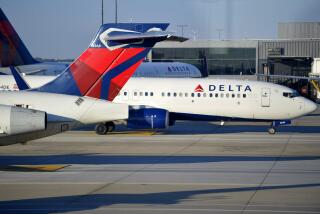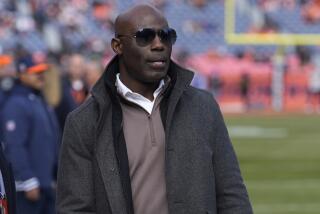A New Focus on Fighting In-Air Risks
- Share via
WASHINGTON — A weekend incident in which passengers and flight attendants subdued a possible suicide bomber is fueling a debate among airlines, passengers and crew members over how to prevent such incidents without creating additional risks.
Some critics are calling on the airlines to provide stronger restraining devices and even nonlethal weapons to be used when passengers and crew must take security into their own hands.
The pressure reflects the extent to which flying now tacitly involves assuming a place in a mutual security compact with airline personnel. Airlines find themselves in the awkward position of having to make passengers aware of their dangerous new roles at the same time they are trying to convince the flying public that the skies are safe.
Twice in recent months, passengers have been called upon to resist dangerous passengers. Pointing to the passengers bound from Paris to Miami on Saturday who used airplane headset cords and their own belts to restrain a man who seemed to be trying to ignite explosives in his shoe, they insist that they cannot do it barehanded.
“When the cabin door closes and the plane pushes back from the terminal, it’s really up to the flight attendants and the passengers to protect themselves,” said David Stempler, president of the Air Travelers Assn., a grass-roots group representing U.S. airline passengers. “And right now they don’t have all the tools they need.”
On Sept. 11, passengers on one of the doomed flights fought with terrorist hijackers, thwarting their apparent efforts to fly the plane into a target in Washington; instead, it crashed in rural Pennsylvania.
Philippe Acas, a 39-year-old Frenchman on Saturday’s transatlantic plane, expressed surprise that the passengers had to supply restraints to bind the suspect, identified as Richard C. Reid, a British citizen.
“We had nothing to tie him up with, so we asked for belts and just tied the guy up,” Acas said Thursday. “Then we asked for a doctor, for a medical kit, and when it arrived, we said, ‘We’re going to give you a shot.’ It was about a half-hour before it took effect.”
The airlines say they rule out guns on planes for fear they will fall into the wrong hands. Added an anonymous flight attendant: “Stun guns and pepper spray could always be used against us.”
After the Sept. 11 hijackings, the government significantly expanded the authorized number of sky marshals, the federal plainclothes police officers who travel on some commercial flights. The government is still recruiting sky marshals, whose total remains classified. But it is nowhere near enough to have marshals on every one of the 24,000 U.S. flights daily.
Acas wondered why there apparently was no sky marshal to subdue the passenger on Saturday’s flight.
“I thought especially on American carriers, they had a couple guys in the crowd traveling incognito,” Acas said. “It shouldn’t have been us doing the job. Because the guy could have had a knife or something. Maybe the flight attendants should have wrestling training and boxing capacity or something.”
To the contrary, the airlines have purposely not trained the flight attendants to try to physically restrain unruly passengers.
“You are part of the safety equipment on board the airplane,” a former United Air Lines flight attendant said she was told in training. “Don’t put yourself at risk,” because you are the only ones with the training to work the doors or other emergency equipment. “If it’s bad enough,” she was instructed, “the passengers will take care of it.”
Until recently, security experts and policymakers focused on bolstering airline security measures on the ground--before passengers got on a plane.
Last month, for instance, President Bush signed into law a wide range of security measures, including mandatory screening of all checked bags by explosive-detection machines by next December and rigorous background checks on ground-support personnel.
The law also beefs up the sky marshal program under the aegis of a new Transportation Security Administration inside the Transportation Department. It also orders the new agency to set up security training guidelines for flight attendants and determine whether stun guns, Mace and other nonlethal weapons should be used against unruly passengers.
Officials say, however, the wave of complex new security measures will take time and practice to implement effectively.
“If someone is drunk and disorderly, then that is not really a security threat,” even though the passenger’s actions could jeopardize the safety of the plane, said Hank Price, a Transportation Security Administration spokesman. “But if a guy is threatening to destroy a plane . . . , we’ll be directing airlines to come up with procedures to deal with that.”
Currently, many major U.S. airlines carry nylon restraints that resemble those used by many police departments to tie suspects’ wrists and ankles. A few also carry rudimentary medical supplies, including tranquilizers.
But no airlines carry nonlethal weapons.
“You don’t want to have anything around that is risky,” said Arthur L. Caplan, director of the Center for Bioethics at the University of Pennsylvania. “You could have gigantic legal liability.”
Even tranquilizers are of questionable value on board airliners, Caplan said. “The efficacy is just so-so,” he said, adding that untrained people might administer a dosage too small to subdue or so large that it could do permanent damage.
Since Sept. 11, airlines have even removed corkscrews and cockpit keys from the cabins to avoid their being used as weapons. But groups representing flight attendants say neither the federal government nor the airline industry has done enough to bolster in-flight security.
“We’ve been working for years to improve flight attendant security training since, like it or not, we are the last line of defense,” said Jeff Zack, a spokesman for the Airline Flight Attendants Assn.
But Zack complained that the airline industry has been more concerned with the bottom line than with safety and has resisted such training.
United Airlines spokeswoman Susana Leyva disputed claims that not enough is being done on board to combat security threats.
“We started a brand-new flight attendant [security] training program in the wake of the Sept. 11 hijackings,” Leyva said. “And we were the second major carrier to announce that we were reinforcing our cockpit doors” to make it more difficult for passengers to barge in on pilots.
Though Leyva said she was heartened that more travelers seemed to be more aware of their surroundings and fellow passengers, “we do not encourage customers” to take control of disruptive passengers without specific instructions from flight crews.
“I can’t speak for all airlines, but at United the safety of our customers is paramount.”
An American Airlines pilot said his company’s policy was to land the plane as quickly as possible in case of a security breach.
The pilot, who asked to remain anonymous, added that American instructs pilots not to leave the cockpit under any circumstances once a plane is airborne. In the past, a co-pilot may have gone back into the cabin to assist flight attendants, he said.
Some experts say that, despite the concern over security risks in the skies, the focus on in-flight threats may be overstated.
“I’m still more interested in who’s looking at the scanner and watching the luggage in the airport lobby than I am in the ability of flight attendants to deal with a disruptive passenger,” Caplan said.
*
Times staff writer John-Thor Dahlburg in Miami contributed to this report.
More to Read
Sign up for Essential California
The most important California stories and recommendations in your inbox every morning.
You may occasionally receive promotional content from the Los Angeles Times.













